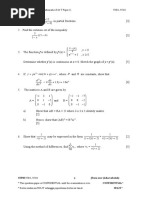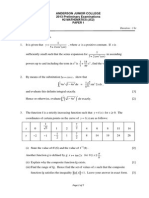Jan & March 08
Jan & March 08
Uploaded by
Agus LeonardiCopyright:
Available Formats
Jan & March 08
Jan & March 08
Uploaded by
Agus LeonardiCopyright
Available Formats
Share this document
Did you find this document useful?
Is this content inappropriate?
Copyright:
Available Formats
Jan & March 08
Jan & March 08
Uploaded by
Agus LeonardiCopyright:
Available Formats
CAMBRIDGE A LEVEL PROGRAMME
A2 TRIAL EXAMINATION MARCH/APRIL 2009
(Jan/March 2008 Intake)
Monday 30 March 2009 8.30 am – 11.30 am
FURTHER MATHEMATICS 9231/01
PAPER 1 3 hours
Additional materials: Answer Booklet/Paper
List of formulae (MF 10)
READ THESE INSTRUCTIONS FIRST
If you have been given an Answer Booklet, follow the instructions on the front cover of the Booklet.
Write your name and class on all the work you hand in.
Write in dark blue or black pen on both sides of the paper.
You may use a soft pencil for any diagrams or graphs.
Do not use staples, paper clips, highlighters, glue or correction fluid.
Answer all the questions.
Give non-exact numerical answers correct to 3 significant figures, or 1 decimal place in the case of angles
in degrees, unless a different level of accuracy is specified in the question.
The use of a calculator is expected, where appropriate.
Results obtained solely from a graphic calculator, without supporting working or reasoning, will not receive
credit.
You are reminded of the need for clear presentation in your answers.
At the end of the examination, fasten all your work securely together.
The number of marks is given in brackets [ ] at the end of each question or part question.
This document consists of 4 printed pages.
© Taylor’s University College Subang Jaya 2009 [Turn over
2
1 The vector x is an eigenvector of the square matrix A with corresponding
eigenvalue λ . Show that if A −1 exists, then λ ≠ 0 . Show also that the vector x is an
eigenvector of A −1 and find the corresponding eigenvalue. [4]
2 The planes П1, П2, П3 have equations x + y + kz = 0, x + ky + z = 0 and kx + y + z = 0
respectively. Find the common line of intersection of the three planes. [5]
3 Find the centroid of the region R in the first quadrant bounded by the x and y axes, the
line y = 1 and the curve y = ( x − 1) 3 . [5]
Find also the centroid of the solid generated when R is rotated completely about the
y-axis. [2]
4 The equation of a circle is given by y 2 + x 2 = r 2 , where r is a positive real number.
(i) Find, using integration, the circumference of the circle, in terms of r . [5]
(ii) Find, in terms of r , the surface area of a sphere of radius r . [3]
d2y dy
5 Find the general solution of the differential equation + 5 + 4 y = 3x 2 − x + 6 .
dx 2
dx
[9]
6 (i) The curve C is defined implicitly by the equation sin( x + y ) = cos xy . Find the
d2y
value of at the point (π, 0). [5]
dx 2
(ii) If y = x 3 e x , prove that
dny
n
= x 3e x + 3nx 2 e x + 3n(n − 1) xe x + n(n − 1)(n − 2)e x
dx
for every positive integer n. [4]
© TUCMC 2009 9231/01/Trial/Jan & Mar 08 Intake
3
7 The linear transformation T : \ 4 → \ 4 is represented by the matrix L , where
⎛ 1 2 −4 1 ⎞
⎜ ⎟
⎜ 2 3 −7 −2 ⎟
L=
⎜ −1 −3 5 −5 ⎟
⎜ ⎟
⎝ 2 5 −9 6 ⎠
(i) Find the dimension of the range space of T . [4]
(ii) Find a basis of the null space of T . [3]
(iii) Find a basis of the column space of T . [3]
7r − 3
8 Express in partial fractions. [3]
r3 − r
Hence, find the sum of the following series
22 36 50 14n − 6
S= + + +" 3 . [6]
1× 2 × 3 2 × 3 × 4 3 × 4 × 5 n −n
Deduce the sum to infinity of the above series. [1]
2
9 Find all solutions of the equation ( + 9) 4 = 1 . [6]
3z − 8
n
⎛2 ⎞
Given ⎜ − 1⎟ = 1 , where n is a positive integer. By expressing z in the form
⎝z ⎠
⎛ kπ kπ ⎞ kπ
r ⎜ cos − i sin ⎟ , show that z = sec , k = 0, 1, ..., n − 1 and state the least
⎝ n n ⎠ n
value of z . [6]
© TUCMC 2009 9231/01/Trial/Jan & Mar 08 Intake [Turn Over
4
10 (i) Given that
π
I n = ∫ 2 sin n x dx ,
0
d
where n is a non-negative integer. By considering
dx
( )
sin n −1 x cos x show that
for n ≥ 2 ,
n −1
In = I n−2 . [5]
n
(ii) The curve C has polar equation
r = 4sin 2θ sin θ ,
where 0 ≤ θ < 2π .
(a) Draw a sketch of C . [3]
(b) Using the results from parts (i) and (ii)(a) above, find the area of the region
enclosed by one loop of the curve C . [4]
11 Answer only one of the following two alternatives.
EITHER
2x2 + 3
The curve C has equation y = .
x 2 + 3x − 4
Q R
(i) Express y in the form P + + . [3]
x −1 x + 4
(ii) Write down the equations of all asymptotes of C . [3]
(iii) Find the coordinates of turning points and determine their nature. [5]
(iv) Sketch the curve C . [3]
OR
The roots of the equation ax 3 + bx 2 + cx + d = 0 , α, β, γ, are in geometric progression.
c
(i) Show that one of the roots is − . [3]
b
(ii) Show that for the roots to be in geometric progression, ac 3 = b3 d . [4]
(iii) Find the possible common ratios in terms of a, b, c, and d. [7]
© TUCMC 2009 9231/01/Trial/Jan & Mar 08 Intake
You might also like
- Pre-Calculus: Quarter 2 - Module 3Document21 pagesPre-Calculus: Quarter 2 - Module 3Cesa BuhianNo ratings yet
- Network Protection Automation Guide Areva 1Document915 pagesNetwork Protection Automation Guide Areva 1eliaseee100% (1)
- Chap 05 Real Analysis: Function of Several VariablesDocument39 pagesChap 05 Real Analysis: Function of Several Variablesatiq4pk100% (4)
- 9231 s10 QP 11Document8 pages9231 s10 QP 11Arinj JaruwatanachaiNo ratings yet
- MathematicsDocument4 pagesMathematicsdkorean493No ratings yet
- Further Mathematics: University of Cambridge International Examinations General Certificate of Education Advanced LevelDocument8 pagesFurther Mathematics: University of Cambridge International Examinations General Certificate of Education Advanced LevelMustafa SalmanNo ratings yet
- 9709 s10 QP 32Document4 pages9709 s10 QP 32roukaiya_peerkhanNo ratings yet
- Further Mathematics: Cambridge International Examinations General Certificate of Education Advanced LevelDocument4 pagesFurther Mathematics: Cambridge International Examinations General Certificate of Education Advanced LevelAshik RaihanNo ratings yet
- Kertas 1Document16 pagesKertas 1juliet84No ratings yet
- Further Mathematics: University of Cambridge International Examinations General Certificate of Education Advanced LevelDocument8 pagesFurther Mathematics: University of Cambridge International Examinations General Certificate of Education Advanced LevelkheyNo ratings yet
- University of Cambridge International Examinations General Certificate of Education Advanced Subsidiary Level and Advanced LevelDocument4 pagesUniversity of Cambridge International Examinations General Certificate of Education Advanced Subsidiary Level and Advanced Levelahnaf.sharar.rhineNo ratings yet
- University of Cambridge International Examinations General Certificate of Education Advanced Subsidiary LevelDocument4 pagesUniversity of Cambridge International Examinations General Certificate of Education Advanced Subsidiary LevelLeo LungaNo ratings yet
- 9709 s13 QP 32Document4 pages9709 s13 QP 32Ananthakrishnan Tinneveli VNo ratings yet
- Ajc H2 Math P1Document5 pagesAjc H2 Math P1yongsimjung00No ratings yet
- 9709 s07 QP 3Document4 pages9709 s07 QP 3api-3765617100% (1)
- 9709 qp3 w07Document4 pages9709 qp3 w07api-3765617No ratings yet
- 2010 IJC H2 Maths Prelims2 P1 - QP - RDocument5 pages2010 IJC H2 Maths Prelims2 P1 - QP - RbluplerNo ratings yet
- 9709 s10 QP 33Document4 pages9709 s10 QP 33roukaiya_peerkhanNo ratings yet
- JC2 Maths H2 2018 MeridianDocument49 pagesJC2 Maths H2 2018 MeridianmathperformanceNo ratings yet
- 9231 s06 QP 1Document4 pages9231 s06 QP 1liuweifengNo ratings yet
- 9709 P3 Compiled Past Papers 2016-2020Document1,033 pages9709 P3 Compiled Past Papers 2016-2020Usman AhmedNo ratings yet
- 2009 TJC P1Document4 pages2009 TJC P1Pin Koon Ee0% (1)
- Core Mathematics C3: GCE Examinations Advanced / Advanced SubsidiaryDocument4 pagesCore Mathematics C3: GCE Examinations Advanced / Advanced Subsidiarynoobkilla123No ratings yet
- University of Cambridge International Examinations Cambridge International Level 3 Pre-U Certificate Principal SubjectDocument4 pagesUniversity of Cambridge International Examinations Cambridge International Level 3 Pre-U Certificate Principal Subjectlaksh bissoondialNo ratings yet
- June 2011 QP - FP2 OCRDocument4 pagesJune 2011 QP - FP2 OCRahmed.ahsanm2005No ratings yet
- Trial STPM P2 2018 SMJK JT SINDocument3 pagesTrial STPM P2 2018 SMJK JT SINMelody OngNo ratings yet
- June 2011 QP - FP2 OCR (A)Document16 pagesJune 2011 QP - FP2 OCR (A)ahmed.ahsanm2005No ratings yet
- A Level H2 Math Meridian JC2 Prelim 2018Document49 pagesA Level H2 Math Meridian JC2 Prelim 2018Akshaya MeiyappanNo ratings yet
- Cambridge International Advanced LevelDocument4 pagesCambridge International Advanced LevelHassan TariqNo ratings yet
- Pre-U Mathematics Blue BookDocument31 pagesPre-U Mathematics Blue BookcleanvmaxNo ratings yet
- University of Cambridge International Examinations General Certificate of Education Advanced Subsidiary LevelDocument4 pagesUniversity of Cambridge International Examinations General Certificate of Education Advanced Subsidiary LevelDilan HarindraNo ratings yet
- MathematicsDocument4 pagesMathematicsNana_Banana_94No ratings yet
- Number and Algebra Paper 2-1: (321 Marks)Document64 pagesNumber and Algebra Paper 2-1: (321 Marks)Parikshit goyaniNo ratings yet
- University of Cambridge International Examinations General Certificate of Education Advanced LevelDocument8 pagesUniversity of Cambridge International Examinations General Certificate of Education Advanced LevelBwalya MwenyaNo ratings yet
- 9709 w03 QP 3Document4 pages9709 w03 QP 3michael hengNo ratings yet
- Mocktest 1Document5 pagesMocktest 1Mapler MapleleafNo ratings yet
- University of Cambridge International Examinations General Certificate of Education Advanced Subsidiary LevelDocument4 pagesUniversity of Cambridge International Examinations General Certificate of Education Advanced Subsidiary LevelhyyyNo ratings yet
- University of Cambridge International Examinations General Certificate of Education Advanced Subsidiary LevelDocument4 pagesUniversity of Cambridge International Examinations General Certificate of Education Advanced Subsidiary LevelhyyyNo ratings yet
- Kelantan STPM 2010 Maths T p1Document3 pagesKelantan STPM 2010 Maths T p1Seow HuaNo ratings yet
- 9709 w15 QP 33Document4 pages9709 w15 QP 33yuke kristinaNo ratings yet
- 9709 s14 QP 32Document4 pages9709 s14 QP 32malyksNo ratings yet
- Mathematics C3 Pure MathematicsDocument3 pagesMathematics C3 Pure MathematicsblackurikillermanNo ratings yet
- 9709_s15_qp_31Document4 pages9709_s15_qp_31Hiba HassanNo ratings yet
- Cambridge Pre-U Certificate Principal SubjectDocument4 pagesCambridge Pre-U Certificate Principal Subjectlaksh bissoondialNo ratings yet
- Resit 2022Document2 pagesResit 2022baggie.baggie.bagsNo ratings yet
- Mathematics C4 Pure MathematicsDocument3 pagesMathematics C4 Pure MathematicsblackurikillermanNo ratings yet
- 9709 s10 QP 11Document4 pages9709 s10 QP 11roukaiya_peerkhanNo ratings yet
- 9709 w06 QP 3Document4 pages9709 w06 QP 3michael hengNo ratings yet
- 2019 Sem 2 Gbs Melaka (Q)Document3 pages2019 Sem 2 Gbs Melaka (Q)Green SlimeNo ratings yet
- VJC Promo Paper 2020 Practice Paper CDocument5 pagesVJC Promo Paper 2020 Practice Paper Cbrandon leeNo ratings yet
- A10285W1 CP3 JuneDocument5 pagesA10285W1 CP3 Juneryanlin10No ratings yet
- AJC H2 Math 2013 Prelim P1Document6 pagesAJC H2 Math 2013 Prelim P1nej200695No ratings yet
- CP3 - June2019 2Document5 pagesCP3 - June2019 2Sifei ZhangNo ratings yet
- CALCULUSDocument52 pagesCALCULUSJoseph TedlaNo ratings yet
- STPM Trial 2009 Matht Q&A (PCGHS, Penang)Document14 pagesSTPM Trial 2009 Matht Q&A (PCGHS, Penang)SimPorNo ratings yet
- Mathematics: University of Cambridge International Examinations General Certificate of Education Advanced LevelDocument4 pagesMathematics: University of Cambridge International Examinations General Certificate of Education Advanced LevelDanielHwangNo ratings yet
- 9709 s13 QP 31Document4 pages9709 s13 QP 31Agus LeonardiNo ratings yet
- Core Mathematics C3: GCE Examinations Advanced / Advanced SubsidiaryDocument4 pagesCore Mathematics C3: GCE Examinations Advanced / Advanced Subsidiarynoobkilla123No ratings yet
- Factoring and Algebra - A Selection of Classic Mathematical Articles Containing Examples and Exercises on the Subject of Algebra (Mathematics Series)From EverandFactoring and Algebra - A Selection of Classic Mathematical Articles Containing Examples and Exercises on the Subject of Algebra (Mathematics Series)No ratings yet
- On the Tangent Space to the Space of Algebraic Cycles on a Smooth Algebraic VarietyFrom EverandOn the Tangent Space to the Space of Algebraic Cycles on a Smooth Algebraic VarietyNo ratings yet
- De Moiver's Theorem (Trigonometry) Mathematics Question BankFrom EverandDe Moiver's Theorem (Trigonometry) Mathematics Question BankNo ratings yet
- A-level Maths Revision: Cheeky Revision ShortcutsFrom EverandA-level Maths Revision: Cheeky Revision ShortcutsRating: 3.5 out of 5 stars3.5/5 (8)
- Semester 2 - Test 1 - TrigonometryDocument5 pagesSemester 2 - Test 1 - TrigonometryAgus LeonardiNo ratings yet
- Psle Maths - Worksheet 26: Solutions Available at Youtube Channel 'Document3 pagesPsle Maths - Worksheet 26: Solutions Available at Youtube Channel 'Agus LeonardiNo ratings yet
- Tutorial 18A: Photoelectric Effect Photoelectric EffectDocument2 pagesTutorial 18A: Photoelectric Effect Photoelectric EffectAgus LeonardiNo ratings yet
- Test 2 - Coordinate GeometryDocument5 pagesTest 2 - Coordinate GeometryAgus LeonardiNo ratings yet
- Psle Maths - Worksheet 28: Solutions Available at Youtube Channel 'Document3 pagesPsle Maths - Worksheet 28: Solutions Available at Youtube Channel 'Agus LeonardiNo ratings yet
- Jan & March 05Document6 pagesJan & March 05Agus LeonardiNo ratings yet
- B) Price Elasticity, Income Elasticity and Cross-Elasticities of DemandDocument10 pagesB) Price Elasticity, Income Elasticity and Cross-Elasticities of DemandAgus LeonardiNo ratings yet
- D) and E) Interaction of Demand and Supply and Market EquilibriumDocument5 pagesD) and E) Interaction of Demand and Supply and Market EquilibriumAgus LeonardiNo ratings yet
- Tutorial 6: Circular Motion: Self-Review QuestionsDocument5 pagesTutorial 6: Circular Motion: Self-Review QuestionsAgus LeonardiNo ratings yet
- Sec 4 E Maths SA2 2018 Cedar GirlsDocument59 pagesSec 4 E Maths SA2 2018 Cedar GirlsAgus LeonardiNo ratings yet
- F) Consumer and Producer SurplusDocument6 pagesF) Consumer and Producer SurplusAgus LeonardiNo ratings yet
- MATH 31B - Week 1 Exponential, Inverse Functions, and Logarithmic Functions (I)Document3 pagesMATH 31B - Week 1 Exponential, Inverse Functions, and Logarithmic Functions (I)Agus LeonardiNo ratings yet
- SASMO 2014 Round 1 Primary 5 ProblemsDocument3 pagesSASMO 2014 Round 1 Primary 5 ProblemsAgus LeonardiNo ratings yet
- SASMO 2014 Round 1 Primary 6 SolutionsDocument10 pagesSASMO 2014 Round 1 Primary 6 SolutionsAgus LeonardiNo ratings yet
- SASMO 2014 Round 1 Secondary 2 SolutionsDocument11 pagesSASMO 2014 Round 1 Secondary 2 SolutionsAgus LeonardiNo ratings yet
- Week 5 Worksheet SolutionDocument1 pageWeek 5 Worksheet SolutionAgus LeonardiNo ratings yet
- MATH 31B - Week 3 Inverse Trigonometric and Hyperbolic Functions, Integration by PartsDocument2 pagesMATH 31B - Week 3 Inverse Trigonometric and Hyperbolic Functions, Integration by PartsAgus LeonardiNo ratings yet
- IGCSE Biology Plan of StudyDocument1 pageIGCSE Biology Plan of StudyAgus LeonardiNo ratings yet
- MATH 31B - Week 2 Integrals Involving Logarithms and L'Hopital RuleDocument3 pagesMATH 31B - Week 2 Integrals Involving Logarithms and L'Hopital RuleAgus LeonardiNo ratings yet
- 14 15 H2 Quantum Physics1 NotesDocument29 pages14 15 H2 Quantum Physics1 NotesAgus LeonardiNo ratings yet
- 14 15 H2 Nuclear Updated Full NotesDocument22 pages14 15 H2 Nuclear Updated Full NotesAgus LeonardiNo ratings yet
- Materials Today: Proceedings: Kanad Sen, Nirmal K. Manna, Nirmalendu BiswasDocument8 pagesMaterials Today: Proceedings: Kanad Sen, Nirmal K. Manna, Nirmalendu BiswasSayan DasNo ratings yet
- Factors WorksheetDocument3 pagesFactors WorksheetPrincyNo ratings yet
- 5 - Heat Eqn - Derivation and SolutionDocument8 pages5 - Heat Eqn - Derivation and SolutionWild BotNo ratings yet
- Big 10 AP Exam Review Calculator Active SolutionsDocument4 pagesBig 10 AP Exam Review Calculator Active SolutionsLaurissaNo ratings yet
- Pretest Cronbach's AlphaDocument4 pagesPretest Cronbach's AlphaHeide Orevillo Apa-apNo ratings yet
- MuhasabahDocument1 pageMuhasabahHanya dzaqifNo ratings yet
- Procedure: Introduction To SIMULINK AM Modulation and DemodulationDocument15 pagesProcedure: Introduction To SIMULINK AM Modulation and DemodulationypobuleshNo ratings yet
- Switching Circuits & Logic DesignDocument13 pagesSwitching Circuits & Logic DesignDr Ravi Kumar A.VNo ratings yet
- Grand Tour (Data Visualisation)Document2 pagesGrand Tour (Data Visualisation)charlotte899No ratings yet
- IT5409 Ch7 Part1 Object Detection v2Document97 pagesIT5409 Ch7 Part1 Object Detection v2Bui Minh DucNo ratings yet
- TE-1A (Paper-2) For FS JCT (Phase-2&4) (Mains & Adv) 06-11-2024 Question PaperDocument9 pagesTE-1A (Paper-2) For FS JCT (Phase-2&4) (Mains & Adv) 06-11-2024 Question PaperMohd Azaan MohammedNo ratings yet
- Hooke's Law Lab ReportDocument3 pagesHooke's Law Lab ReportNur Syahirah Hanafi75% (4)
- Unit1 Sana AnjumDocument148 pagesUnit1 Sana Anjumvinaybhatt027No ratings yet
- CH2 Electric Potential and Capacitance 2019Document6 pagesCH2 Electric Potential and Capacitance 2019PrachiNo ratings yet
- Packaging DynamicsDocument56 pagesPackaging DynamicsPankaj ShahNo ratings yet
- Space Gass 12.5 Help ManualDocument841 pagesSpace Gass 12.5 Help Manualozbuild60% (5)
- Specific SpeedDocument10 pagesSpecific SpeedVijaysarathy KrNo ratings yet
- CSE 231L Lab Report 1Document23 pagesCSE 231L Lab Report 1Rayhan Amin 2212830042No ratings yet
- Spelling Bee 5-6th Grade ListDocument4 pagesSpelling Bee 5-6th Grade ListMaria Camila Fonseca CaroNo ratings yet
- NE 304: Introduction To Nuclear Engineering: Topic:Equation of ContinuityDocument29 pagesNE 304: Introduction To Nuclear Engineering: Topic:Equation of ContinuityMaher1420No ratings yet
- SYLLABUS DETAILS Philosophy PDFDocument108 pagesSYLLABUS DETAILS Philosophy PDFRajdeep DeyNo ratings yet
- Probability and Tree Diagrams Questions MMEDocument7 pagesProbability and Tree Diagrams Questions MMEbb domanNo ratings yet
- Ict AssignmentDocument3 pagesIct Assignment123vidyaNo ratings yet
- Factor AnalysisDocument16 pagesFactor AnalysissairamNo ratings yet
- Algebra Drill 5Document2 pagesAlgebra Drill 5alvaro baronNo ratings yet
- HPhys Unit 03 CAPM Packet 2013Document12 pagesHPhys Unit 03 CAPM Packet 2013Kelly O'Shea100% (3)
- Topic 2: Flowmeter Measurement Apparatus 2.1 THEORY: RotameterDocument6 pagesTopic 2: Flowmeter Measurement Apparatus 2.1 THEORY: Rotameterpelinces_cityNo ratings yet














































































































